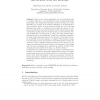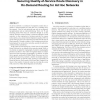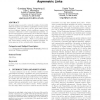105
click to vote
ADHOCNOW
2004
Springer
15 years 6 months ago
2004
Springer
Sensor networks consist of multiple low-cost, autonomous, ad-hoc sensors, that periodically probe and react to the environment and communicate with other sensors or devices. A prim...
127
click to vote
ADHOCNOW
2004
Springer
15 years 6 months ago
2004
Springer
Abstract. We consider the problem of bootstrapping self-organized mobile ad hoc networks (MANET), i.e. reliably determining in a distributed and self-organized manner the services ...
119
Voted
ADHOCNOW
2004
Springer
15 years 6 months ago
2004
Springer
We consider a wireless sensor network in which each sensor is able to transmit within a disk of radius one. We show with elementary techniques that there exists a constant c such t...
146
click to vote
ADHOCNOW
2004
Springer
15 years 6 months ago
2004
Springer
Many ad hoc routing algorithms rely on broadcast flooding for location discovery or more generally for secure routing applications, particularly when dealing with Byzantine threat...
145
Voted
ADHOCNOW
2004
Springer
15 years 6 months ago
2004
Springer
Recent theoretical results show that it is optimal to allow interfering sources to transmit simultaneously as long as they are outside a well-defined exclusion region around a de...
109
click to vote
ADHOCNOW
2004
Springer
15 years 6 months ago
2004
Springer
Supporting nodes without Global Positioning System (GPS) capability, in wireless ad hoc and sensor networks, has numerous applications in guidance and surveying systems in use toda...
ADHOCNOW
2004
Springer
15 years 6 months ago
2004
Springer
We address the question of finding sensors’ coordinates, or at least an approximation of them, when the sensors’ abilities are very weak. In a d dimensional space, we define ...
104
Voted
ADHOCNOW
2004
Springer
15 years 6 months ago
2004
Springer
Topology control is the problem of assigning transmission power values to the nodes of an ad hoc network so that the induced graph satisfies some specified property. The most fun...
119
click to vote
SASN
2004
ACM
15 years 6 months ago
2004
ACM
An ad hoc network is a collection of computers (nodes) that cooperate to forward packets for each other over a multihop wireless network. Users of such networks may wish to use de...
115
click to vote
PEWASUN
2004
ACM
15 years 6 months ago
2004
ACM
In many instances, an ad hoc network consists of nodes with different hardware and software capabilities as well as power limitations. This is the case of ad hoc grids where devi...



